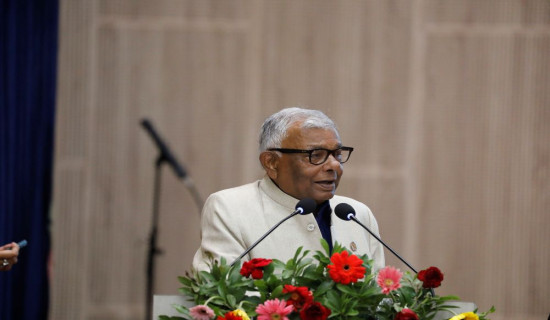- Saturday, 31 May 2025
Confounding Conundrums Of Cosmic Entities
Rishi Shah
The cool and clear night skies of this month offer mysterious marvels of planets Jupiter, Saturn, Uranus, Neptune and Mars along with confounding conundrums of cosmic entities. Planets Mercury and Venus would stay out of sight due to their proximity to the Sun.
They would be racing through zodiacal constellations Libra (scales) and Scorpius (scorpion). Ruddy Mars could be admired after sunset in eastern sky. It would climb high in southern sky by midnight. It would be rushing towards western horizon during dawn. Mars would be mingling with stars of constellation Taurus (bull).
Giant stars Aldebaran (Rohini) and Ain would be uniquely 65 and 147 light-years away and curiously charming Crab Nebula (M1) would be clearly 6500 light-years away from us. They could be appreciated astonishingly below Mars, which would be closest to earth at modestly 81.5 million kilometers (0.5445 AU) during end of November. One Astronomical Unit (AU) has been defined as mean distance between earth and Sun.
It would be calculated to be circa 150 million kilometers. Planet Jupiter could be perceived in south-eastern sky after sundown. It would be ascending the southern sky late at night and would then be descending towards western horizon by midnight.
Jupiter and Uranus
Jupiter could be applauded in the barren expanse unfurling below the cute circlet asterism belonging to constellation Pisces (fishes). Planet Saturn could be discerned after night-fall in southern sky. It could be glimpsed above southern horizon before midnight.
It could be spotted among the stars situated at the eastern corner of the triangle-mimicking constellation Capricornus (sea goat).
Uranus would be entering the eastern sky after nightfall. It would be gleaming in the southern sky at around midnight. It would be sinking slowly towards the western horizon very late at night.
It would be capriciously cavorting with stars in the compact constellation Aries (ram). The blue-green planet Uranus would be at opposition to the Sun and also make its closest approach to earth (perigee) on 09 November.
It would be fully illuminated by the Sun and be seemingly brighter than at any other time of the year. It would be shining all night long. Due to its distance, it would only appear as a tiny blue-green star-like scintillating speck even through powerful telescopes.
The ice giant planet Uranus as our Solar System's second outermost planet has been revolving around the Sun from a span of utter 2.87 billion kilometers (19.2 AU) once every 84.3 years.
With its mass of barely 14.5 times and its radius merely four times that of earth has been spinning once every 17.2 hours. Its rotational axis has been skewed strangely 98 degrees from its orbital plane and quirkily may as well be lying down. It was detected by German-born English astronomer William Herschel in 1781.
Uranus has been devoid of solid surface and could be comprised of gas. Thick clouds of small crystals, predominantly of ammonia, could determine Uranus’ opaque appearance. Uranus could possess substantial quantities of water, ammonia, methane and various hydrocarbons at its liquid core, which would bestow its blue hue. Planet Neptune would be noticed at dusk in south-eastern sky. It would be floating then in southern sky. It would be lost in western sky after midnight. It could be recognized with stars sketching the eastern flank of constellation Aquarius (water bearer).
The fantastic full moon would befall on 08 November. This full moon has been acclaimed popularly as the full beaver moon, because this time of year beaver traps would be set before the swamps and rivers would freeze.
The tenebrous new moon would betide on 23 November. A total lunar eclipse would exceptionally enthrall eclipse-enthusiasts on 08 November. The eclipse would be visible from eastern Russia, Japan, Australia, the Pacific Ocean, Northern Europe and North America.
The eclipse would be followed from any location where the moon would hover above the horizon at the eclipse-time. It would be difficult for us to observe it from Kathmandu since the moon would rise partway through the eclipse and attain an appreciable altitude above the horizon by the time the eclipse would end. Eclipses of the moon are easy to watch with the unaided eyes. Unlike solar eclipses, lunar eclipses would be safe to look at without even peering through any kind of filter.
They occur whenever the earth would slide between the moon and Sun, such that it would obscure Sun's light and cast eerie shadow onto the moon. When the moon's disk would lie completely in shadow, it would often take on a spectacular reddish-brown color, as some of the Sun's red light would be bent around the edge of the earth's globe by its atmosphere.
The eclipse would begin at 01:48 PM, when the moon would first enter the earth's shadow called the penumbra. At 02:55 PM the moon would touch earth's umbra.
As the moon's face would creep increasingly into the earth's umbra, we would see our planet's circular shadow sweep across the moon. Eventually the moon would immerse within the earth's umbra at 04:02 PM and the total eclipse would commence.
At 05:27 PM the moon would leave the earth's umbra. At 06:34 PM the moon would be fully outside the earth's umbra ending the partial eclipse. At 07:41 PM the moon would be free from earth's penumbra.
The moon at the midpoint of the eclipse would be residing in constellation Aries. The waning gibbous moon would be rising at 05:09 PM and be setting at 06:56 AM on the next day.
Leonid Meteor
Leonid meteor shower would perhaps display up to fifteen meteors per hour at its peak this year on the night of 17 November till the morning of 18 November 2022. This startling shower would manifest unique cyclonic maximum almost every 33 years, where hundreds of meteors per hour could be bewitchingly witnessed.
That last of these events had transpired in 2001. The Leonids has been probably produced from dust grains left behind by parent periodic comet 55P/Tempel–Tuttle with an orbital period of 33.22 years.
It was independently disclosed by German astronomer Wilhelm Tempel in 1865 and by American astronomer Horace Parnell Tuttle in 1866. The shower would run annually from 06 to 30 November.
Although the second quarter waning crescent moon would block many fainter meteors this year, the Leonids could unpredictably still put up a good shimmering show of shooting stars. Meteors would emerge from the constellation Leo.
Meteors in annual showers would be named from the radiant point in the starry sky from which they allegedly spring. This shower’s name would come from the constellation Leo (lion), because these meteors would exude outward from the vicinity of stars representing the imaginary lion’s mane.
The meteors would apparently emanate from near the star Algieba. The radiant would rise around wee hours of midnight and be highest in the sky at dawn. Blue-white main-sequence double star Regulus (Magha) would be sheer 77.5 light-years away from earth. Its traditional moniker would mean the little king. The baffling binary star Algieba with a third optical component would be basically 126 light-years away. Its traditional Arabic name Algieba could roughly be translated to the forehead.
Constellation Leo
Constellation Leo would be evidently rising just before midnight in mid-November. Regulus would act as the dot of the illusionary backwards question mark of stars that has been fascinatingly known as the sickle asterism. Meteor showers would arise when the earth would plough through the meteoroid stream left behind in the wake of the passing comets and asteroids.
The Leonids have been fast moving stream which encounter the path of earth and impact at whooping 72 kilometers per second. Larger particles which would be fairly 10 millimeter across and possess mass of half a gram would be generating more luminous meteors. An annual Leonid shower could deposit up to thirteen tons of petit particles across the entire planet.
Streaking meteors would be relished whenever one of these pieces would collide with the earth's atmosphere, typically burning up and disintegrating at height of purely up to one hundred kilometers above earth’s surface.
(Shah is an academician at NAST and patron of Nepal Astronomical Society)
How did you feel after reading this news?

















